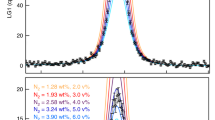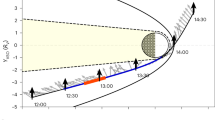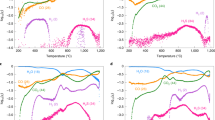Abstract
Saturn's largest moon, Titan, remains an enigma, explored only by remote sensing from Earth, and by the Voyager and Cassini spacecraft. The most puzzling aspects include the origin of the molecular nitrogen and methane in its atmosphere, and the mechanism(s) by which methane is maintained in the face of rapid destruction by photolysis. The Huygens probe, launched from the Cassini spacecraft, has made the first direct observations of the satellite's surface and lower atmosphere. Here we report direct atmospheric measurements from the Gas Chromatograph Mass Spectrometer (GCMS), including altitude profiles of the constituents, isotopic ratios and trace species (including organic compounds). The primary constituents were confirmed to be nitrogen and methane. Noble gases other than argon were not detected. The argon includes primordial 36Ar, and the radiogenic isotope 40Ar, providing an important constraint on the outgassing history of Titan. Trace organic species, including cyanogen and ethane, were found in surface measurements.
This is a preview of subscription content, access via your institution
Access options
Subscribe to this journal
Receive 51 print issues and online access
$199.00 per year
only $3.90 per issue
Buy this article
- Purchase on Springer Link
- Instant access to full article PDF
Prices may be subject to local taxes which are calculated during checkout



Similar content being viewed by others
References
Hunten, D. M., et al. in Saturn (eds Gehrels, T. & Shapley Matthews, M.) 671–759 (Univ. Arizona Press, Tucson, 1984)
Kunde, V. G. et al. C4H2, HC3N and C2N2 in Titan's atmosphere. Nature 292, 686–688 (1981)
Niemann, H. B. et al. The Gas Chromatograph Mass Spectrometer for the Huygens probe. Space Sci. Rev. 104(1), 553–591 (2002)
Lorenz, R. D., McKay, C. P. & Lunine, J. L. Photochemically driven collapse of Titan's atmosphere. Science 275, 642–644 (1997)
Niemann, H. B. et al. Chemical composition measurements of the atmosphere of Jupiter with the Galileo Probe Mass Spectrometer. Adv. Space Res. 21, 1455–1461 (1998)
Lunine, J. I. & Stevenson, D. J. Clathrate and ammonia hydrates at high pressure: Application to the origin of methane on Titan. Icarus 70, 61–77 (1987)
Bar-Nun, A., Kleinfeld, A. I. & Kochavi, E. Trapping of gas mixtures by amorphous ice. Phys. Rev. B 38, 7749–7754 (1988)
Owen, T. & Gautier, D. Touring the Saturn system: The atmospheres of Saturn and Titan. Space Sci. Rev. 104, 347–376 (2002)
Tobie, G., Grasset, O., Lunine, J. I., Mocquet, A. & Sotin, C. Titan's internal structure inferred from a coupled thermal-orbital model. Icarus 175, 496–502 (2005)
Owen, T. & Bar Nun, A. Comets, impacts and atmospheres. Icarus 116, 215–226 (1995)
Hersant, F., Gautier, D. & Lunine, J. Enrichment in volatiles in the giant planets of the Solar System. Planet. Space Sci. 52, 623–641 (2004)
Mousis, O., Gautier, D. & Bockelée-Morvan, D. Turbulent model of the Saturn subnebula: Implications for the origin of methane in Titan's atmosphere. Icarus 156, 162–175 (2002)
Atreya, S. K., Donahue, T. M. & Kuhn, W. R. Evolution of a nitrogen atmosphere on Titan. Science 201, 611–613 (1978)
Kuramoto, K. & Matsui, T. Formation of a hot proto-atmosphere on the accreting giant icy satellite: Implications for the origin and evolution of Titan, Ganymede, and Callisto. J. Geophys. Res. 99(E10), 21183–21200 (1994)
McKay, C. P., Scattergood, T. W., Pollack, J. B., Borucki, W. J. & Van Ghysegahm, H. T. High temperature shock formation of N2 and organics on primordial Titan. Nature 332, 520–522 (1988)
Bockelee-Morvan, D., Crovisier, J., Mumma, M. J. & Weaver, H. A. The composition of cometary volatiles in Comets II. (eds Festou, M., Weaver, H. A. & Keller, H. U.) 391–423 (Univ. Arizona Press, Tucson, 2004)
de Bergh, C., Lutz, B., Owen, T. & Chauville, J. Monodeuterated methane in the outer solar system. III. Its abundance on Titan. Astrophys. J. 311, 501–510 (1986)
Coustenis, A., Bézard, B. & Gautier, D. Titan's atmosphere from Voyager infrared observations: II. The CH3D abundance and D/H ratio from the 900–1,200 cm-1 spectral region. Icarus 82, 67–80 (1989)
Orton, G. et al. The D/H ratio on Titan from ISO and IRSHELL Data 81 (ESA report SP 338, Noordwijk, 1992)
Coustenis, A. et al. Titan's atmosphere from ISO mid-infrared spectroscopy. Icarus 161, 383–403 (2003)
Meier, R. & Owen, T. Cometary deuterium. Space Sci. Rev. 90, 33–43 (1999)
Flasar, F. M. et al. Titan's atmospheric temperatures, winds, and composition. Science 308, 975–978 (2005)
Kouvaris, L. C. & Flasar, F. M. Phase equilibrium of methane and nitrogen at low temperatures—Application to Titan. Icarus 91, 112–124 (1991)
Sagan, C., Thompson, W. R. & Khare, B. N. Titan: a laboratory for prebiological organic chemistry. Acc. Chem. Res. 25, 286–292 (1992)
Marten, A., Hidayat, T., Biraud, Y. & Moreno, R. New millimeter heterodyne observations of Titan: Vertical distributions of nitriles HCN, HC3N, CH3CN, and the isotopic ratio 15N/14N in its atmosphere. Icarus 158, 532–544 (2002)
Lunine, J. I., Yung, Y. L. & Lorenz, R. D. On the volatile inventory of Titan from isotopic abundances in nitrogen and methane. Planet. Space Sci. 47, 1291–1303 (1999)
Hidayat, T. et al. Millimeter and submillimeter heterodyne observations of Titan: Retrieval of the vertical profile of HCN and the 12C/13C ratio. Icarus 126, 170–182 (1997)
Owen, T., Mahaffy, P. R., Niemann, H. B., Atreya, S. K. & Wong, M. Protosolar nitrogen. Astrophys. J. 553, L77–L79 (2001)
Owen, T., Biver, N., Marten, A., Matthews, H. & Meier, R. Saturn VI (Titan). (ed. Green, D. W. E.) IAU Circ. 7306, 3, (1999)
Wong, A.-S., Morgan, C. G., Yung, Y. L. & Owen, T. Evolution of CO on Titan. Icarus 155, 382–392 (2002)
Strobel, D. F. The photochemistry in the atmosphere of Titan. Icarus 21, 466–470 (1974)
Yung, Y. L., Allen, M. & Pinto, J. P. Photochemistry of the atmosphere of Titan—Comparison between model and observations. Astrophys. J. Suppl. Ser. 55, 465–506 (1984)
Wilson, E. H. & Atreya, S. K. Current state of modelling the photochemistry of Titan's mutually dependent atmosphere and ionosphere. J. Geophys. Res. 109, E06002, doi:10.1029/2003JE002181 (2004)
Boetius, A. Lost city life. Science 307, 1420 (2005)
Kelley, D. S. et al. A serpentinite-hosted ecosystem: the lost city hydrothermal field. Science 307, 1428–1434 (2005)
Chiodini, G. Carbon dioxide Earth degassing and seismogenesis in central and southern Italy. Geophys. Res. Lett. 31, L07615 (2004)
Foustouskos, D., Seyfried, W. E. & Dionysis, I. Hydrocarbons in hydrothermal vent fluids: the role of chromium-bearing catalysts. Science 304, 1002–1005 (2004)
Hersant, F. G., Gautier, D. & Lunine, J. Enrichment in volatiles in the giant planets in the Solar System. Planet. Space Sci. 52, 623–641 (2004)
Mousis, O., Gautier, D. & Bockelee-Morvan, D. An evolutionary turbulent model of Saturn's subnebula: implications for the origin of the atmosphere of Titan. Icarus 156, 162–175 (2002)
Holland, H. The Chemical Evolution of the Atmosphere and Oceans 39 (Princeton Univ. Press, Princeton, 1984)
Owen, T. C. The composition and origin of Titan's atmosphere. Planet. Space Sci. 30, 833–838 (1982)
Engel, S., Lunine, J. I. & Norton, D. L. Silicate interactions with ammonia-water fluids on early Titan. J. Geophys. Res. 99, 3745–3752 (1994)
Elachi, C. et al. Cassini RADAR's first views of the surface of Titan. Science 308, 970–974 (2005)
Sotin, C. et al. Release of volatiles from a possible cryovolcano from near-infrared imaging of Titan. Nature 435, 786–789 (2005)
Lebonnois, S. et al. Seasonal variations of Titan's atmospheric composition. Icarus 152, 384–406 (2001)
Waite, J. H. et al. Ion neutral mass spectrometer results from the first flyby of Titan. Science 308, 982–986 (2005)
Wilson, E. H. & Atreya, S. K. Chemical sources of haze formation in Titan's atmosphere. Planet. Space Sci. 51, 1017–1033 (2003)
Israel, G. et al. Huygens Probe Aerosol Collector Pyrolyser Experiment. Space Sci. Rev. 104(1), 433–468 (2002)
Acknowledgements
This paper is dedicated to the memory of T. Donahue, who contributed to the planning and development of the GCMS, and died before the Huygens probe encountered Titan. We acknowledge the HASI team, who provided the atmospheric pressure–temperature–altitude data to the GCMS team. We thank F. M. Flasar, R. H. Brown and C. Sotin for providing preprints of their Cassini papers. We also thank G. Tobie for information on the story of clathrate hydrates within Titan, F. Hersant for discussions on enrichments by clathration in giant planets and D. Strobel for his discussions of atmospheric loss. The contributions of personnel at the NASA Goddard Space Flight Center, the University of Michigan, the Ohio State University and the University of Paris are acknowledged. We thank the personnel at the European Space Research and Technology Centre (ESTEC) and the European Space Operations Centre (ESOC) for their technical support and guidance during this mission. We acknowledge NASA, ESA and CNES for support of the mission.
Author information
Authors and Affiliations
Corresponding author
Ethics declarations
Competing interests
Reprints and permissions information is available at npg.nature.com/reprintsandpermissions. The authors declare no competing financial interests.
Rights and permissions
About this article
Cite this article
Niemann, H., Atreya, S., Bauer, S. et al. The abundances of constituents of Titan's atmosphere from the GCMS instrument on the Huygens probe. Nature 438, 779–784 (2005). https://doi.org/10.1038/nature04122
Received:
Accepted:
Published:
Issue Date:
DOI: https://doi.org/10.1038/nature04122
This article is cited by
-
Mid-infrared imaging spectroscopic measurements of C2H4 frost simulating the outer solar system environments
Earth, Planets and Space (2024)
-
Emerging roles of mitochondrial functions and epigenetic changes in the modulation of stem cell fate
Cellular and Molecular Life Sciences (2024)
-
Formation, stabilization and fate of acetaldehyde and higher aldehydes in an autonomously changing prebiotic system emerging from acetylene
Communications Chemistry (2023)
-
Exploration of Enceladus and Titan: investigating ocean worlds’ evolution and habitability in the Saturn system
Experimental Astronomy (2022)
-
Enceladus and Titan: emerging worlds of the Solar System
Experimental Astronomy (2022)
Comments
By submitting a comment you agree to abide by our Terms and Community Guidelines. If you find something abusive or that does not comply with our terms or guidelines please flag it as inappropriate.



